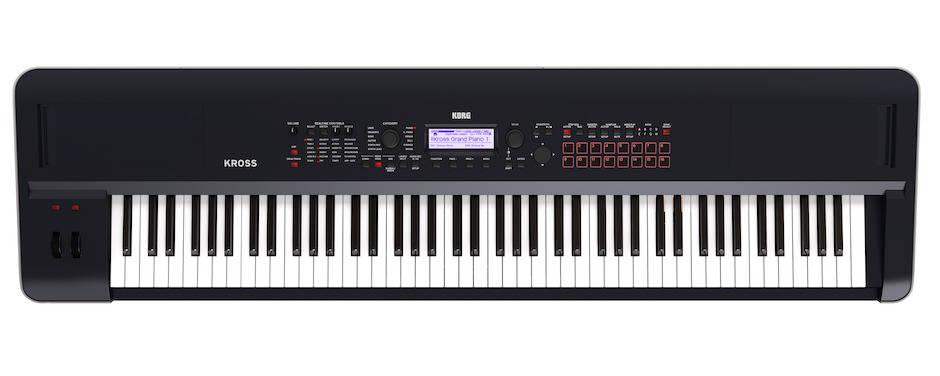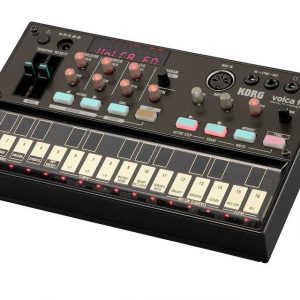Korg Kross 2-88
$659.99
Looking for maximum expression and sound in a lightweight and portable synthesizer? Look no further than the Korg Kross 2-88!
Compare
Description
The Korg Kross 2-88 Synthesizer is a high-quality synthesizer designed for professional musicians and beginners alike. It is designed to offer flexible sound creation and intuitive operation, making it an ideal instrument for both on-stage performances and studio recordings.
One of the key features of the Korg Kross 2-88 Synthesizer is its 88-key weighted keyboard, which provides a realistic playing experience similar to that of a traditional piano. This makes it an excellent instrument for pianists who want to expand their range and explore new soundscapes.
The synthesizer includes a comprehensive range of sounds, including acoustic and electric pianos, drums, guitars, basses, and strings. Additionally, there are 134 different effects that can be applied to any sound, including reverb, chorus, and delay. This makes it easy for musicians to customize their sound and create unique textures.
The Korg Kross 2-88 Synthesizer also includes a wide range of functions designed to make playing and creating music easier than ever. For example, there are 16 pads that can be used to play and trigger different sounds, making it easy to create loops and beats. Additionally, there is a built-in audio recorder that can be used to capture performances and ideas, which can be later edited and refined in a DAW (digital audio workstation).
One of the standout features of the Korg Kross 2-88 Synthesizer is its ability to connect to a computer or mobile device via USB or wireless Bluetooth MIDI. This allows musicians to use the Kross 2-88 as a controller for their software synths or to send and receive MIDI messages directly to their DAW.
Overall, the Korg Kross 2-88 Synthesizer is an excellent instrument for musicians of all levels. Its versatile sound library, realistic keyboard, and user-friendly interface make it an ideal tool for exploring new sounds and creating innovative music. Whether you’re a seasoned pro or just starting out, the Korg Kross 2-88 Synthesizer is definitely worth considering.
Korg Kross 2-88 properties
| Product name |
Kross 2-88 |
| Brand |
Korg |
| Type |
Keyboard Instruments |
| Keyboard Instrument |
Synthesizer |
| Keys |
Yes |
| Number of Keys |
88 pcs |
| Pads |
Yes |
| Rotary Controls |
Yes |
| Pre-Programmed Songs |
Yes |
| Pre-Programmed Sounds |
Yes |
| Connections |
3.5mm (Aux), 6.3mm (1/4″RTS), Headphone, MIDI, MIDI In, MIDI Through USB, Memory Card, USB |
| Colour |
Black |
| Power Supply |
Battery |
Frequently Asked Questions:
How do I properly program and save custom sounds using the Korg Kross 2-88 synthesizer's editing features?
Programming and saving custom sounds on the Korg Kross 2-88 synthesizer involves several steps. Here is a general guide to help you get started:
1. Power on your Kross 2-88 and select the "Edit" mode by pressing [Edit] button located at the top left of the keyboard. Select the type of sound you want to edit by navigating through the preset banks using the [Preset] selector buttons (located below the display) or use the touchpad to search for specific sounds. Once you have selected a sound, begin editing it by adjusting various parameters using the knobs and sliders located on the front panel of the keyboard. To access more detailed editing options, press the [Edit] button again to enter the "Advanced Edit" mode. Here, you can modify individual waveforms, envelopes, filters, effects, and other parameters in greater detail using the touchpad or data wheels. As you make changes, the display will show you the current parameter values and any changes you make will be saved automatically. To undo a mistake, press the [Undo] button located at the top right of the keyboard. When you are satisfied with your custom sound, save it by pressing the [Store] button located below the display. You can then select a bank or location to save it in using the [Bank/Program] selector buttons. To load a previously saved custom sound, press the [Load] button located below the display and select the bank and program number you want to recall. Finally, you can also copy, rename, delete, or backup your custom sounds using the "Utility Mode" which can be accessed by pressing [Utilities] button located at the top left of the keyboard. Remember to always save your changes before turning off the synthesizer as unsaved changes will be lost. Also, it's a good idea to periodically back up your custom sounds onto an external device for safekeeping.
How do I properly program and save custom sounds using the Korg Kross 2-88's synthesis engine?
Connect your Korg Kross 2-88 to a computer via USB cable. Launch the Korg MIDI Studio software on your computer. Select "KROSS2" from the list of devices in the software's control panel (located in the top left corner). Load a sound or create a new one by selecting "Edit Program" or "Edit Combination" in the Korg MIDI Studio software. Adjust the various synthesis parameters to your liking using the software's graphical interface. You can use the mouse, keyboard, or MIDI controller connected to the computer to make adjustments. Save your custom sound by selecting "Save" in the software's menu and choosing a location on your computer to save it. Make sure to choose the correct format (such as ". Close the software and disconnect your Korg Kross 2-88 from the computer. Your custom sounds should now be accessible in the synthesis engine of your Kross 2-88.
What are the primary differences between the Korg Kross 2-88's internal effects routing and its external effects routing, particularly when using a MIDI-controlled effect processor?
* The Kross 2-88 has a comprehensive set of built-in effects, including reverb, delay, chorus, flanger, and distortion. These effects can be accessed directly from the unit's control panel or via MIDI commands. When using internal effects routing, the audio signal is processed entirely within the Kross 2-88 before being sent to the output stage. This means that any effects processing occurs in real-time, allowing for smooth and dynamic sound manipulation. External Effects Routing:
* The Kross 2-88 also allows you to send the audio signal externally to a separate effects processor via its S/PDIF or MIDI interfaces. When using external effects routing, the audio signal is sent out of the Kross 2-88 and processed by an external device, such as a digital audio workstation (DAW) or a dedicated effects unit. This approach provides greater flexibility in terms of available effects processing options, as you can utilize any external processor that supports MIDI control. MIDI-Controlled Effect Processor:
When using a MIDI-controlled effect processor with the Kross 2-88, several key differences come into play:
1. Program Change Messages**: To switch between different effects settings or programs on an external processor, you'll need to send program change messages from the Kross 2-88 via MIDI. This allows you to seamlessly change your effects configuration without having to manually adjust parameters. CC (Control Change) Messages**: The Kross 2-88 can also send CC messages to control external processors in real-time. This enables dynamic changes to effect parameters, such as volume, pan, or filter cutoff, based on the performance data being sent from the keyboard. MIDI Channel Assignments**: When using MIDI-controlled effect processors, it's essential to assign specific MIDI channels for each processor to prevent conflicts and ensure proper communication between devices. In summary:
* Internal effects routing offers a wide range of built-in effects that can be accessed directly or via MIDI commands. External effects routing provides greater flexibility by allowing the use of any external processor supported by the Kross 2-88's MIDI interface. When using a MIDI-controlled effect processor, program change and CC messages enable dynamic control over external processors from within the Kross 2-88.
Before you buy Korg Kross 2-88








Georgia –
I recently had the pleasure of laying eyes on this synthesizer at a store located at 130 Commercial Rd, Portsmouth PO1 1EJ, United Kingdom, and I must say it’s a fascinating device. As an amateur musician living in Portsmouth, I can see how this keyboard could be useful for creating unique sounds for my indie band, but I’ve also seen professionals use it to add depth to their electronic tracks, so its versatility is undeniable. The fact that it’s power-efficient makes me feel slightly less guilty about contributing to the never-ending cycle of consumption and pollution on our planet, especially considering India’s ambitious plan to launch European Proba-3 satellites on Dec 4th, which will create artificial eclipses in space – I mean who needs natural ones when we can just make them ourselves?